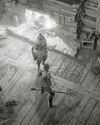A familiar beat with a different tempo, as Nagoshi returns to Kamurocho.

Within seconds of its opening cutscene, we know exactly where we are, as the camera glides down a bustling street, past a Poppo store sign and through the window of a second-floor office. Our first objective, meanwhile, asks us to walk up Nakamichi Street, make a right before Smile Burger, and head down Nakamichi Alley towards Pink Street. The waypoint would be surplus to requirements if we weren’t playing in Japanese. The Yakuza series’ star – no, not Kazuma Kiryu – is back.
Surprisingly, that wasn’t the initial plan. “For a time we were considering not using Kamurocho,” says Nagoshi. “However, the goal here was to drastically change the game content from the Yakuza series, and we wanted to avoid exhausting our budget on a brand-new map. I also felt confident that we could create compelling new gameplay even without a new map.”
هذه القصة مأخوذة من طبعة Christmas 2018 من Edge.
ابدأ النسخة التجريبية المجانية من Magzter GOLD لمدة 7 أيام للوصول إلى آلاف القصص المتميزة المنسقة وأكثر من 9,000 مجلة وصحيفة.
بالفعل مشترك ? تسجيل الدخول
هذه القصة مأخوذة من طبعة Christmas 2018 من Edge.
ابدأ النسخة التجريبية المجانية من Magzter GOLD لمدة 7 أيام للوصول إلى آلاف القصص المتميزة المنسقة وأكثر من 9,000 مجلة وصحيفة.
بالفعل مشترك? تسجيل الدخول

NO MORE ROOM IN HELL 2
You're not alone in the dark

WINDBLOWN
Life after Dead Cells

COLLECTED WORKS - JOSH SAWYER
Journeying to the Forgotten Realms, Infinity and beyond with the RPG veteran

SCREENBOUND
Going deep in a mind-bending hybrid of perspectives

Trigger Happy
Shoot first, ask questions later

Grand strategist
Paradox's Mattias Lilja addresses the publisher's recent difficulties - and the plan to right the ship

Diablo IV
A progress report on the games we just can't quit

Ghosts 'n Goblins Resurrection
In Capcom's diabolical tribute, evil goes far deeper than the demons on the screen

SERENITY FORGE
How a near-death experience lit a fire in the Colorado-based developer and publisher

THE MAKING OF...ALIEN: ISOLATION
How a strategy-led studio built a survival horror masterpiece in Ridley Scott's image